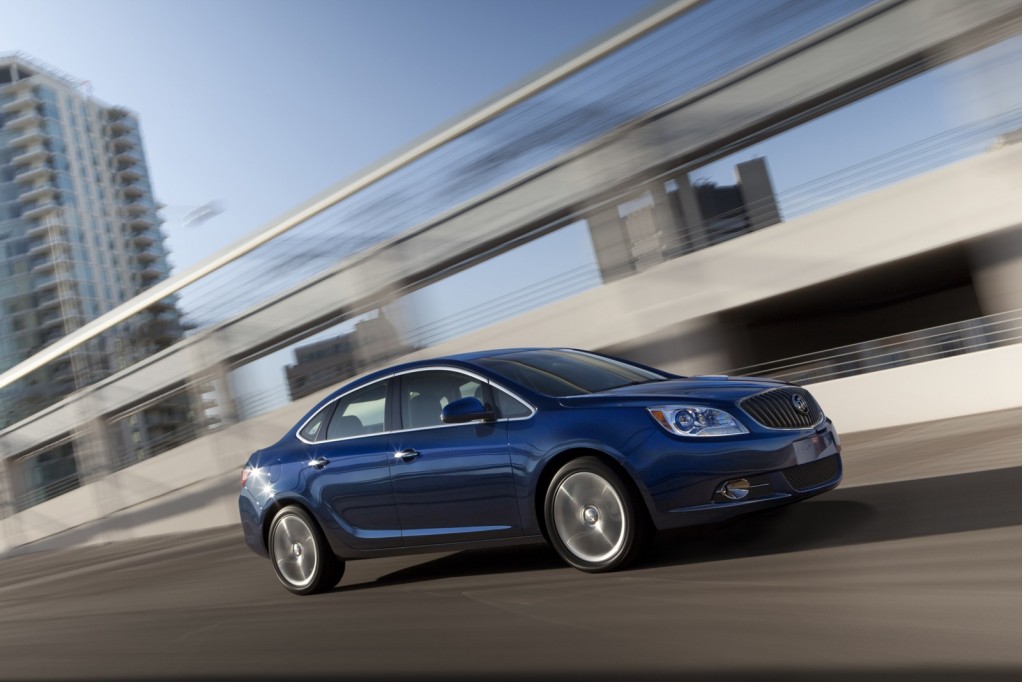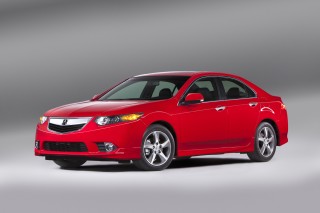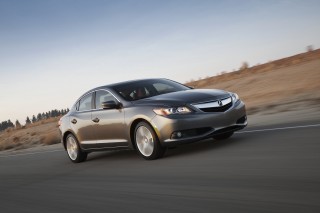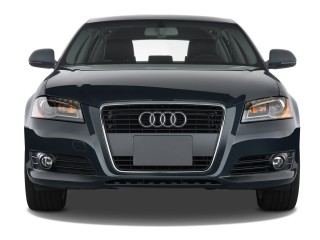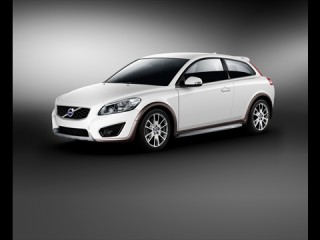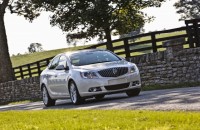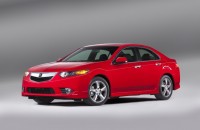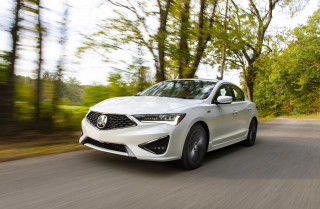Likes
- Front seats are excellent
- Interior is truly luxurious
- Rides better than most luxury compacts
- New safety, connectivity features
- Bargain base price
Dislikes
- Not truly quick
- Tacky "chrome" "ventiports"
- Gas mileage low for the class
- Rear-seat leg room is snug
Buying tip
features & specs
Comfortable, well-appointed and inexpensive on the luxury-car scale, the 2013 Buick Verano is a mild performer--that is, until the turbo T arrives later this year.
The Buick Verano finds its way into more compelling territory for 2013, only a year after it first went on sale. It's not giving up its handsome sheetmetal or chucking its quiet cabin, but it is adding turbocharging to its four-cylinder engine--a change that makes the Turbo the Verano we'd pick every time.
The 250-horsepower Turbo changes the mood of the even-tempered base car, lifting its tepid performance into something more interesting. And it's just in time, since the arena of premium small cars is about to get more challenging, with the Verano and Acura ILX soon to face an onslaught of German-made four-doors, starting with the 2014 Mercedes-Benz CLA.
With turbocharging solving the woes of sluggish acceleration, the Verano continues to impress us as far more than a badge-engineered Chevy--which it isn't, though it shares some significant suspension and body structures with the compact Cruze. With its own style and a high-value set of luxury features, the Verano carves out a new niche for Buick as a 'tweener compact sedan, one with premium content and a bargain pricetag. From the outside in, the Verano looks every bit the Buick, though sized down to compact proportions. With a long and arching roofline like that on the LaCrosse, a low hood line, and a grille sized and shaped like that on the mid-size Regal, the Verano blends effortlessly into today's Buick lineup and is one of the prettier efforts in a segment that has some real styling clunkers. Almost all its styling cues are uniformly tasteful and subdued, but we take issue with the portholes on the hood--they're afterthoughts, and seem tacky in contrast to the smoothly sculpted shape. Inside, the compact Verano has its act together, with a richly finished dash and softly lit gauges.
A 180-horsepower, 2.4-liter four-cylinder engine is standard on the 2013 Verano. Not quick by any means, it's capable only of 0-60 mph times of about 8.6 seconds, but the front-driver feels a little more eager than that, thanks to a responsive six-speed automatic and an overall level of refinement that's easily among the best in its segment, if not the best. Life gets much more interesting when the 2.0-liter, 250-hp four is applied: it's good for 0-60 mph times of 6.2 seconds, and top speed drifts up to about 129 mph, with almost no perception of lag or audible change from the engine bay.
The same is mostly true for ride and handling, though we'd prefer it were less the case. The Verano's ride is softly sprung, even so on the Turbo, which gets only slightly stiffer front shocks and the same set of tires. Handling is better than safe, in the sum: it can be fun and responsive despite lots of body roll, more so than the dull alternatives, but the modestly quicker steering and tauter feel of the Turbo could easily be the base setup--and the Turbo could go twice as far, and still be half as aggressive as any Acura. Four-wheel disc brakes provide plenty of stopping power, even if the pedal feel is old-money spongy.
Gas mileage is a sticking point, though. The EPA rates the Verano at 21/32 mpg, not so impressive considering the Cruze's top 42-mpg highway figure. It is better than nearly all luxury-brand sedans its size (except for hybrids like the Lexus HS 250h and Lincoln MKZ Hybrid). The Turbo penalty? Just one mile per gallon.
Interior appointments are worthy of comparison to those of any luxury car this size. The front-wheel-drive layout grants the Verano a very spacious interior. Up front, its seats are excellent, with day-long support on offer for a range of body types. There's even terrific seat travel and headroom for taller folks. In the back, the seats are contoured well but legroom is predictably tight; hardly a surprise given the car's small proportions. On the flip side, its trunk is large and shaped well, while its rear seatbacks can fold almost flat for more storage.
A delightfully refined, comfortable, quiet interior distinguishes the Verano from less-expensive compact sedans. Quiet Tuning is a keyword at Buick, and it describes much of the Verano's personality. Through meticulous sound-deadening measures like triple-sealed doors, laminated side glass, an acoustic windshield, and various foams, baffles, and mats, the Verano is very, very quiet inside. Buick has worked to isolate road, wind, and engine noise, so even if you're driving the Verano hard, on some of the coarsest surfaces, you'll be able to have a soft-spoken conversation.
Crash-test figures from the NHTSA come in at five stars overall, and the Verano's earned the Top Safety Pick award from the IIHS. Equipment-wise,the Verano delivers: ten standard airbags, electronic stability control, and anti-lock brakes with assist, plus OnStar Automatic Crash Response. Rear parking sensors are available, and a rearview camera is standard; Turbos have blind-spot monitors standard, too.
The Verano is clearly not a full-scale luxury car, but it's not priced against Cadillacs. Starting in the low $20,000s, the Verano is equipped with a solid roster of convenience and luxury features, including dual-zone automatic climate control, steering wheel audio controls, Bluetooth, a single USB input, and the Buick Intellilink touchscreen infotainment system, which includes voice controls and Pandora and Stitcher apps. An extra-cost Convenience Group adds heated exterior mirrors, an auto-dimming inside mirror, and rear parking sensors, while the Leather Group adds heated seats, a power driver's seat, Bose audio, push-button keyless starting, and leather upholstery. All that comes standard on the Turbo. A heated steering wheel and navigation are among few options, with a fully loaded Verano coming in well under $30,000, where the Turbo price begins.
2013 Buick Verano Styling
The 2013 Buick Verano has an understated appeal, and a very refined cabin.
Under the skin it's related to the Chevy Cruze, but all the Buick Verano's sheetmetal and cockpit pieces are its own--and it makes a distinct difference.
The Verano, to our eyes, looks like a larger, more luxurious vehicle than the Cruze, thanks to some well-conceived details that relate it to the rest of the Buick lineup. The roofline is long and arches in the same way as the LaCrosse full-size sedan, while the headlamps and small grille are more in line with the European-derived Regal. In all, the look is conservative, but flowing and clean, and we think, handsome enough to attract new buyers to Buick--especially since the other vehicles in its price and size class are so undistinguished.
The bright-metallic trim applied to the Verano walks a fine line for modern luxury. The chrome look is back to being cliche, after years of Germanic deletion from upwardly mobile brands. Here Buick has executed it tastefully, for the most part. We especially like the light veins of chrome that angle around the rear corners of the Verano, then angle downward toward the center in back. We do take issue with one detail, however. The Buick ventiports, which find their way again to the Verano's front fenders. They're a little tacky for the upmarket crowd Buick is shooting for with the Verano.
Spotting the new Verano Turbo will mean hunting down its dual exhausts and its small trunklid spoiler. No mesh grille inserts are applied, no faux carbon fiber is peeled or stuck to it. It's way against type--but so refreshing, if you've ever lost yourself in a parking lot of pimped-alike R or M or Q cars.
The Verano's interior design is swoopy and radical for a Buick, with attractive two-tone themes and a high window sill line that wraps from the top of the doors to the front of the dashboard. Door trim carries through the broad arcs of the dash, and matte metallic trim looks classy, not garish, here. The small windows at the front of the front doors fit in stylistically, and help with visibility, too.
2013 Buick Verano Performance
The Verano puts most of its money into quietness and smoothness, but it's fairly enjoyable to drive, too.
The 2013 Buick Verano stands by with its mildly entertaining levels of performance, courtesy a well-sorted independent suspension, electric power steering, and a smooth four-cylinder engine. When it's turbocharged, straight-line performance is much more urgent--but handling is only mildly altered, leaving us to think the Verano might be better off with the turbo's suspension and steering settings across the board.
The Verano may be related to the Chevy Cruze, but instead of the Cruze's turbocharged 1.4-liter four, it derives its power from a 180-horsepower, 2.4-liter four-cylinder engine with direct injection. The front-driver teams power to a six-speed automatic transmission. The combination is smooth and responsive enough, but not truly quick--Buick estimates its 0-60 mph acceleration at 8.6 seconds, a bit quicker than the Cruze, and roughly competitive with the like of the Acura ILX and Audi A3. The four-cylinder requires a heavy touch on the throttle, really only coming to life over 4000 rpm. And since it lacks paddle shifters, you'll want to slide the automatic's shift lever to the side to engage manual control of the gears.
All the while, if you're driving hard, this whole “quiet tuning” thing plays mind games. With so much foam and matting, engine sounds distant, even at full throttle--not at all a bad thing, really.
The Verano Turbo has a different story to tell. With displacement downsized to 2.0 liters, power is boosted to 250 horsepower through the small miracle of turbocharging. Peak torque of 260 pound-feet arrives down at 1,700 rpm and sticks around all the way 5,500 rpm, near the redline. Behind the Verano's thickly padded firewall and dense layer of acoustic glass, there's hardly a whistle or a growl, not much of an audible that it's working at full boost--but it's still shoving the Verano Turbo to 60 mph in 6.2 seconds or less. Top speed is tire-limited to 129 mph, and gas mileage barely suffers a mile per gallon. You can look at the choice between powertrains as an economics test, or a Darwinian challenge. Either way, you're weeding yourself out of one pool or the other.
It's a much more subtle difference between the cars at the ride-and-handling level. The Verano's suspension layout, and the basic geometry of it, are shared with the Chevy Cruze, although the pieces themselves are different. With a MacPherson strut design in front, paired with a Z-link (Watt's linkage) design in back, GM engineers argue that you actually get better, more predictable response and better body control on quick transitions, no matter the surface. even compared to an independent setup. A relatively quick steering ratio (with a fat, somewhat small-diameter steering wheel) complete the hints of sportiness, and four-wheel disc brakes provide plenty of stopping power, even if the pedal feel is old-lux spongy.
Handling is better than you might think, given the Verano's relatively soft ride; it's safe, responsive, and even quite fun, with a sense of confidence and more enjoyment than in cushy alternatives such as the Lexus ES 350. Still, the Verano Turbo has more solid moves, more confidence, and it could easily be tuned even more aggressively for the power on tap. The front shocks are stiffer, but only by about 10 percent, to accommodate about 100 pounds of added weight; the electric power steering gets remapped for quicker, slightly more weighty responses. There are no aggressive air intakes, no fatter tires than the base 235-series rolling stock, either.
The Verano Turbo is faster, yes, but it's only slightly more taut. We can see stiffer shocks, thicker anti-roll bars, even faster steering and another twist of the screw on the turbo's boost--but Buick says there's only one place for that in the lineup, and that place belongs to the Regal GS. The Verano is hardly pulse-quickening, but for now, mission creep isn't one of its problems.
2013 Buick Verano Comfort & Quality
The Verano's peaceful cabin is roomy for front passengers and agreeable enough for those in back.
Comfortable and quiet, with a phenomenally refined cabin at its price point or even above, the Buick Verano sets itself apart from other compact sedans, and even some bigger premium four-doors. The Verano simply filters the outside world in all the ways you'd expect from a luxury car.
It starts with making the most of the compact dimensions, with well-shaped seats that feel plush and supportive. The cabin's spacious, thanks to front-wheel drive, and those front seats are excellent, with long-distance comfort for a wide range of drivers and lots of headroom and seat travel to accommodate tall drivers.
The Buick's rear bench seat is contoured for a pair of adults and a third short-stint passenger, too. It's a compact, so there's less legroom, and fitting five long-legged adults in the Verano at once will require some geometry skills.
Quiet Tuning is a keyword at Buick, and it describes much of the Verano's personality. Through meticulous sound-deadening measures like triple-sealed doors, laminated side glass, an acoustic windshield, and various foams, baffles, and mats, the Verano is very, very quiet inside. Buick has worked to isolate road, wind, and engine noise, so even if you're driving the Verano hard, on some of the coarsest surfaces, you'll be able to have a soft-spoken conversation. Trunk space is large and well-shaped, and rear seatbacks fold forward nearly flat, with a wide opening.
2013 Buick Verano Safety
Safety scores are excellent in the Verano.
With both crash-test agencies reporting its scores, and new safety gear for the model year, the Buick Verano earns major kudos for passenger protection.
Every Verano comes with standard safety gear that's exceptional in the class. There are ten airbags (including knee airbags in front); anti-lock brakes, traction and stability control; and new for this year, a rearview camera. It also has standard OnStar with Automatic Crash Response, and a new opt-in service called FamilyLink that allows parents to see where their teenage drivers are at all times.
Among the other opt-in features on non-Turbo Veranos are rear parking sensors, and blind-spot monitors with cross-traffic alerts. The Turbo has rear parking sensors, a rearview camera, and blind-spot monitors standard.
As for crash-test scores, the National Highway Traffic Safety Administration (NHTSA) gives the Verano five stars overall, with the same rating in all categories save for a four-star score in rollover resistance.
The Insurance Institute for Highway Safety (IIHS) has, and with "good" scores on all its tests, it dubs the Verano one of its Top Safety Pick winners. It hasn't performed its new small-overlap crash test on the Verano yet, which means its TSP+ rating isn't available to the compact sedan.
Finally, the issue of connectivity in cars has been addressed with IntelliLink, which uses an LCD touchscreen and Bluetooth and steering-wheel controls to give drivers a less distracting way to control audio, phone, and navigation while on the go. It's simpler in function than Ford's MyFord Touch, but has less functionality as well.
2013 Buick Verano Features
The price tag says Chevrolet, but the features are more in line with Cadillac.
The Verano straddles the line between commuter-duty compact sedans and more upscale, near-luxury four-doors. For 2013, the compact Buick adds more standard features, making its relatively low base price seem even more reasonable.
For Chevy prices, the Buick Verano delivers a premium set of features even in base form. All Veranos come with power windows, locks, and mirrors; remote start; automatic climate control; cloth upholstery; an electronic parking brake; an AM/FM/CD player with steering-wheel controls and a USB port; and satellite radio. A rearview camera is now standard.
The Verano also has standard Buick Intellilink, a connectivity suite that links Bluetooth, an LCD touchscreen, and when paired, a user's smartphone, for media controls and hands-free calling. It also can run the optional navigation system with voice commands, when ordered. We like the IntelliLink's system for its simplicity, and for its configurable screens--you can place icons for apps like Pandora and Stitcher among those for AM, FM, and XM.
The Verano can be fitted with option packages. The Convenience package bundles rear parking sensors with heated side mirrors and an auto-dimming rearview mirrors; the leather package adds just that, plus a power driver seat, heated front seats, Bose premium audio, and pushbutton start. Both these and the premium package are equipped with blind-spot monitors and cross-traffic alerts, both new features for 2013.
Among the available stand-alone options are the navigation system and a heated steering wheel. All said, options on the Verano can drive the bottom line toward, but just shy of, $30,000.
The Verano Turbo has its own standard features, above and beyond those offered on the normally aspirated car. They include dual exhausts; sport pedals; a small trunklid spoiler; and the features from the Verano's leather and convenience packages, including Bose audio, heated seats, and a heated leather-wrapped steering wheel. The 2013 Buick Verano Turbo is priced from $29,990, including an $885 destination charge.
2013 Buick Verano Fuel Economy
Overall gas-mileage numbers are high, but in its class the Verano isn't particularly economical.
Buick's upscale brand image hasn't been in conflict with gas mileage on its larger cars. The LaCrosse and Regal both now come standard with mild-hybrid eAssist technology, which lifts their fuel economy into direct competition with other mid- and full-size sedans.
The Verano is a bit further behind in its pack. Though it shares some body structure and suspension pieces with the 42-mpg Chevy Cruze, the Verano has a larger-displacement, 2.4-liter four-cylinder under the hood.
With the six-speed automatic transmission, the standard Verano is rated by the EPA at 21 miles per gallon in the city cycle, and 32 mpg highway. That's significantly off the pace set by the Cruze and by other compact sedans like the Mazda3, Ford Focus and Hyundai Elantra, all of which earn 40-mpg highway ratings.
The choice to fit a larger four-cylinder gives the Verano a smoother, more confident character than it would likely have with the Cruze's 1.4-liter turbo engine, but its gas mileage just isn't as good. The Verano's gas mileage is, however, better than nearly all luxury-brand sedans its size (except for hybrids like the Lexus HS 250h and Lincoln MKZ Hybrid).
The Verano Turbo makes the base four-cylinder engine look even more compromised. It's rated at 21/30 mpg with the automatic, and 20/31 mpg with the manual transmission. That's still well off the pace of mid-size, mass-market sedans like the Altima, Accord, and Fusion, but more acceptably close to their performance-minded models.
